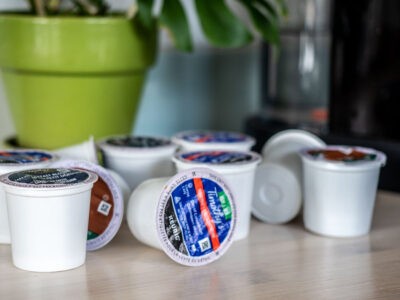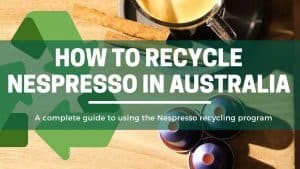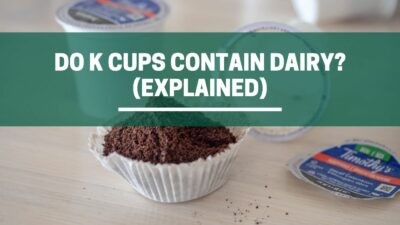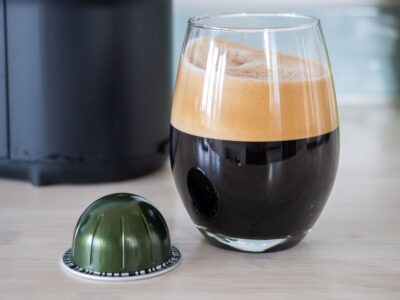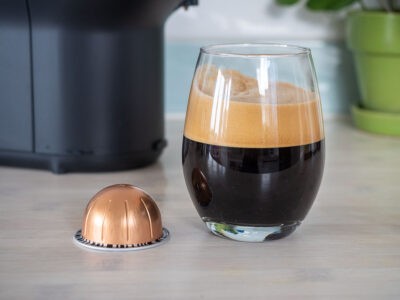Coffee 101, Milk Guides, Recommendations
The Best Milk For Frothing (All Types Compared)
There’s nothing quite like a perfectly crafted brew with a rich, creamy-frothed milk topping.
But what’s the secret to achieving an immaculate foam?
The answer lies in the milk you use.
Comparing the ‘frothability’ of all milks, whole milk reigns supreme. Its high fat and protein content creates a creamy and stable foam. If you prefer a dairy-free alternative, you can opt for oat, soy, and almond milk. Most have additives, like gellan gum, to create a dreamy foam you love.
Join us as we explore the qualities of the most common types of milk so you can choose your next, best frothing partner.
Why Listen To Us? Well, because we KNOW coffee! In fact, we make our own coffee, coffee machine cleaners, and reusable capsules which we've sold to over 41 countries. Our team ouf experts include Tristan (an engineer), Claire (a food writer) and Richy (a barista). So, whether you're looking for a recipe or repair guide, we've got you covered 💚
Table of Contents
What Is The Best Type Of Milk For Frothing?
The best milk for frothing is whole milk. It contains around 3.25% fat and 3.3% protein. This duo produces a thick and stable foam, with a melt-in-your-mouth texture.
For dairy-free alternatives, soy, almond, and oat yield better results. They have binding gums–gellan, xanthan, guar, added to them to produce abundant foam.
| Milk Type | Ranking (Best to Worst) | Notes |
|---|---|---|
| Whole Milk (3.5% or greater) | 1 | Best option for frothing |
| 2% Milk (reduced fat) | 2 | |
| Oat Milk | 3 | Read our oat milk frothing guide |
| Soy Milk | 4 | Read our soy milk frothing guide |
| Almond Milk | 5 | Read our almond milk frothing guide |
| Macadamia Milk | 6 | |
| Coconut Milk | 7 | Easy to burn |
| Skim Milk (<0.5% Fat) | 8 | Far more difficult to froth than reduced fat milk |
| Rice Milk | 9 |
Why Do Some Types Of Milk Froth Easier Than Others?
A milk’s ability to froth is mainly influenced by its protein and fat content.
Protein creates a stable foam, while fat accounts for the creamy mouthfeel. Here’s how these compounds complement each other to create a luscious foam.
1. Caseins
Caseins, a type of milk protein, play a critical role in foam quality. They stabilize air bubbles, resulting in a thick and velvety foam.
Caseins are amphiphilic–have both hydrophilic (water-loving) and hydrophobic (water-repelling) properties. This property allows them to form a protective layer around the air bubbles which helps prevent the bubbles from bursting or collapsing.
2. Proteins
Whey protein contributes to the volume of the foam. It can absorb and hold large amounts of air, creating a fluffy texture.
When milk is heated and frothed, the proteins unfold and then reorganize themselves into a network of interconnected protein chains.
This protein network traps air bubbles, stabilizes them, and creates a thick, creamy foam.
3. Fat vs proteins
Both fat and protein play essential roles in milk frothing, but they have slightly different effects on the texture and stability of the foam.
Fat, primarily fat globules, creates a cage for air bubbles, which the protein attaches to and protects.
A decent amount of fat is necessary to create a creamy mouthfeel. But when you use milk with high-fat content, you risk destabilizing the protein.
When you heat milk, fat globules melt and break down the layer meant to protect air bubbles.
This often results in large air bubbles that die out instead of the velvety microfoam suited for lattes and cappuccino.
Finding the right balance of fat and protein is key to creating a rich, stable foam.
What Milk Do Baristas Use?
Baristas use whole or 2% milk. The milks have a beautiful balance of fat and protein, which helps to create a creamy and rich foam that holds up well.
They also have a slightly sweet flavor that compliments the taste of most brews.
Baristas may also use non-dairy milk alternatives–almond, soy, or oat milk, to cater to customers with dietary restrictions or preferences.
What Milk Froths The Best (Overall)
Best dairy milk
- Whole milk: Contains around 3.25% fat and 3.3% protein and creates the thickest and most stable foam. It also has a slightly sweet flavor to liven the taste of your favorite brew.
- 2% milk (reduced fat): Has reduced fat, which means it has a great frothing ability. It also creates a sweet, creamy, consistent froth.
Best non-dairy milk
Non-dairy, or plant-based milk, does not contain enough protein and fat to maintain the foam. It’ll froth, but the air bubbles die out as soon as you add them to your brew.
The best option would be those with additives like gellan or xanthan gum. The compounds act as emulsifiers and thickeners that bind to milk calcium, creating a stable froth.
Terrific options include soy, oat, and almond milk.
What Dairy Milk Froths Best
| Type of Milk | Full Fat (Whole Milk) | Skim Milk | Barista-Grade Milk |
| Fat Content/100ml | 3.25% | <0.5% | 3.25% |
| Protein Content/100ml | 3.3-4% | 3.4% | 3.3-4% |
| Foam Quality | Thick, soft, and stable foam | Lots of foam, but less stable than whole milk | Thick, soft, and stable foam |
| Flavor | Sweet and creamy | Neutral Taste | Sweet and creamy |
Frothing full fat
Full fat, sometimes called whole milk, contains about 3.25% of fat and 3.3% of protein. It produces the thickest and most stable foam. It has a sweet taste and produces a creamy mouthfeel.
Frothing skim milk
Skim milk is fortified with protein and has most, if not all, fat removed. This makes it easy to work with to produce a dreamy foam. It creates an abundant foam, though not as stable as whole milk.
Frothing barista-grade milk
When looking to create barista-worthy froth, whole milk is the better option. It develops into a balanced, sweet, and creamy foam.
What Non-Dairy Milk Froths The Best
| Type of Milk | Oat Milk | Almond | Soy Milk | Rice Milk | Coconut Milk | Macadamia Milk | Hemp Milk |
| Fat Content/100ml | 0.25% | 0.2-0.4% | 0.4-1.53% | 0.24% | 24% | 7% | 0.6-1% |
| Protein Content/100ml | 0.4% | 0.4% | 2.7% | 0.07% | 2% | 2% | 0.6% |
| Foam Quality | Creamy texture | Velvety, glossy microfoam | Thick and creamy foam | Thin foam | Thicker, more viscous | Voluminous froth | Light, stable foam |
| Flavor | Slightly sweet with an oaty aftertaste | Nutty flavor | Mild, woody, earthy taste | Mild, slightly sweet flavor | Sweet and nutty | Nutty, creamy flavor | Earthy, seedy taste |
There’s a myriad of excellent non-dairy milk on the market. Keep in mind these milks may produce a thinner foam. Also, some have a distinct nutty and earthy flavor, which might not be to your liking.
Frothing oat milk
Oat milk is a preferred alternative amongst lactose-intolerant individuals and vegans.
It has water-soluble fiber which helps it steam, froth, and foam and pour effectively.
When looking for barista-grade oat milk, Oatly Barista or Califi Farms Barista are worth exploring. They have gellan gum added to them to achieve a creamy texture similar to milk, with an oaty taste.

Frothing almond milk
Similar to oat milk, almond milk has binding gums–gellan and xanthan, added to it. It produces a glossy microfoam and has a distinct nutty flavor to complement different brews.

Frothing soy milk
Because of its high protein content, soy milk produces a thick and creamy foam, similar to whole milk. However, the foam may be less stable and can collapse or curdle when added to acidic brews.
Soy milk’s flavor is more pronounced–woody and earthy, and can be overpowering if not balanced properly with the coffee.
Frothing rice milk
Rice milk is less suited for frothing and foaming. It has a thin texture–not even additives can redeem its inability to froth. It does have a mild, slightly sweet flavor, so it’s a fantastic option if you’re not looking to prepare frothed beverages.
Frothing coconut milk
Coconut milk contains a significant amount of fat, which creates a pleasant, creamy mouthfeel.
Plain coconut milk doesn’t froth well because it has low protein content, while those formulated for professional use contain gellan and guar gum, creating a perfect froth.
Coconut milk has a thicker, more viscous texture with the natural sweetness of coconut.
Frothing macadamia milk
Macadamia milk has a creamy texture and can froth fairly well. It has a nutty flavor that can add richness to frothed drinks.
Most brands blend pea protein and gellan gum to help create a voluminous foam. A few worth exploring include Milkadamia Latte Da.
Frothing hemp milk
100% Hemp milk has a thin texture and may not froth as well. For a decent foam, consider those with xanthan gum.
The gum binds to calcium to enhance the milk’s frothing ability and stability. Hemp milk adds a nutty, earthy flavor to your brews.
How To Froth Milk Like A Pro (4 Methods)
And now the fun begins! Once you have your preferred milk at hand, use one of the techniques below to create a barista-worthy froth.
For each of these methods, heat the milk between 55 and 65°C (131-149°F) before frothing.
You can froth milk with an electric whisk
- Pour 250ml (8 oz) of milk into a wide and deep container.
- Tilt the container, insert the whisk, and turn it on.
- Whip air into the milk by swirling the whisk for 2-5 minutes.
- Transfer into a pitcher. Swirl and tap it on the counter.
- Pour over your favorite brew.
Use a French press
- Pour 250ml (8 oz) of milk into the French press.
- Pump the milk 50-100 times.
- Transfer into a pitcher. Swirl and gently tap it on the counter.
- Pour over your favorite brew.

Use a milk-frothing wand
- Pour 250ml (8 oz) of milk into a pitcher.
- Insert the wand into a container.
- Create a whirlpool, while keeping half of the tip exposed to air.
- After a minute, fully submerge the tip.
- Froth for up to 3 minutes until creamy.
- Transfer into a pitcher. Swirl and gently tap it on the counter.
- Pour over your favorite brew.

Use a shaker bottle or sealed container
- Pour 250ml (8 oz) of milk into a 1-liter container. Seal tightly.
- Shake vigorously for 1-3 minutes.
- Once you achieve your desired foam, transfer it into a milk jug.
- Gently swirl and tap the jug on the counter.
- Pour over your brew.
Troubleshooting: Why Won’t My Milk Froth?
Below are factors that can inhibit your milk’s frothing ability and a quick guide to fixing the issue.
- High-fat content: Protein is the major building block of milk foam. Milk with a substantial amount of fat destabilizes the protein.
Opt for whole or 2% milk. They both have a beautiful balance of fat and protein, creating a voluminous, creamy, and stable foam.
- Freshness: Fresher milk froths better than milk that has been sitting in the fridge for a while. The proteins in fresh milk are still intact, making it easier to create a stable microform.
As milk ages, the protein structure breaks down, making it difficult to achieve a good froth.
Try using milk that hasn’t been sitting in the refrigerator for too long.
- Temperature: Heat your milk up to 65°C (149°F); 55°C (131°F) is ideal.
Anything beyond 68°C (154°F), the proteins denature completely. The milk won’t froth as effectively and can result in flavor loss.
Milk Frothing Frequently Asked Questions
Q. How does milk fat affect froth?
Fat is necessary to create a creamy mouthfeel. But when you use milk with high-fat content, you risk destabilizing the protein, resulting in the foam collapsing.
Q. What milk is best for cappuccino?
The best milk for cappuccino is whole or 2% milk. They have a decent amount of fat and protein to create a velvety foam with a slightly sweet flavor.
The best dairy-free alternatives are soy or almond milk.
Q. What milk makes the thickest foam?
Whole milk yields the thickest and most stable foam.
Q. What milk does Starbucks use for foam?
Starbucks uses 2%, nonfat, soy, coconut, and almond milk.
Q. How hot should milk be to froth?
You should heat your milk between 55 and 65°C (131-149°F) before frothing. Anything beyond 68°C (154°F) and the proteins denature completely. The milk won’t froth as effectively and will impart an unpleasant taste to your coffee.
Conclusion
The type of milk you use for frothing can make or break a latte. When looking to create a creamy foam, use whole or 2% milk. They have a perfect balance of fat and protein to create a velvety foam, adding a perfect finishing touch to any coffee-based beverage.
If you’re lactose intolerant or vegan, soy, almond, and oat milk are excellent alternatives. They have vegan-friendly binding agents like gellan, guar, and xanthan gum added to them to produce a rich foam.
The next time you’re making a latte at home, consider experimenting with different types of milk to find the ideal frothing partner.



